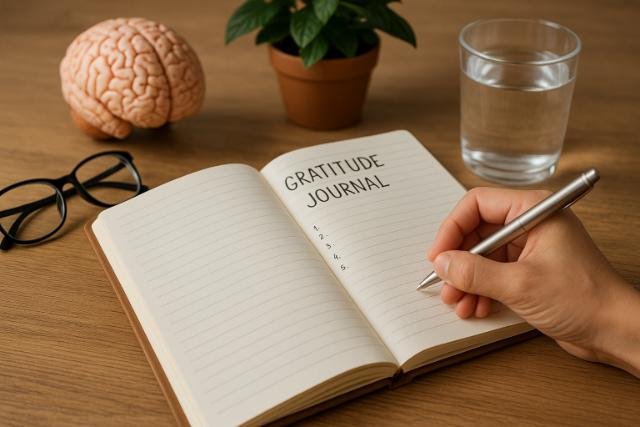Introduction
Gratitude journaling has become one of the most powerful yet simple self-development practices to improve mental well-being, emotional resilience, and overall life satisfaction. Rooted in positive psychology and supported by neuroscience, this reflective habit helps individuals focus on appreciation rather than lack. The goal of gratitude journaling is not merely to write nice things but to reshape cognitive patterns, enhance mindfulness, and foster long-term happiness. In this article, we will explore science-backed benefits of gratitude journaling, step-by-step methods to start, and how to make it a consistent part of your daily life.
Establish a Clear Intention for Gratitude Journaling
Setting a clear purpose gives structure to your gratitude journaling practice. Before you begin writing, determine whether your goal is to reduce stress, improve mood, enhance relationships, or cultivate optimism. This intention acts as a guiding principle for what you record each day, ensuring your practice aligns with your emotional and mental needs.
When defining your intention, ask yourself what outcomes you wish to experience such as peace, clarity, emotional balance, or deeper connection. Write this intention at the start of your journal as a reminder. This helps your brain associate journaling with meaningful results rather than obligation.
Over time, your intention evolves. As you progress, your focus may shift from external gratitude like things you own or receive to internal gratitude such as qualities you develop. This transition is crucial because it deepens self-awareness and sustains motivation.
Choose a Meaningful Focus
Select themes that align with your values such as personal growth, relationships, or health. A meaningful focus keeps your journaling emotionally relevant and prevents it from becoming repetitive.
Create a Visual Reminder
Place your journal in a visible spot like your nightstand or desk. Visual cues reinforce consistency and remind your brain of the emotional reward associated with journaling.
Select the Right Gratitude Journal Format
The medium you choose for gratitude journaling influences engagement and longevity. Some people prefer classic paper journals while others use digital tools or apps. The best format is one that feels natural, accessible, and encourages expression without friction.
Paper journals promote deeper reflection through tactile engagement, while digital journals offer convenience and reminders. You can also combine both by writing detailed entries by hand while maintaining a short digital list on busy days.
Your format should complement your lifestyle. If you travel often, digital tools may suit you. If you enjoy slow mornings, a handcrafted notebook can enhance mindfulness. The key is to create an environment that feels safe and inspiring.
Compare Digital vs. Handwritten Journaling
| Format | Benefits | Best For |
| Digital Journals | Easy access, reminders, data backup | Busy professionals |
| Handwritten Journals | Emotional depth, better memory recall | Reflective thinkers |
Personalize Your Journal Design
Choose materials or apps that reflect your aesthetic such as soft covers, calming colors, or themed templates. Personalization strengthens emotional attachment and turns journaling into a rewarding ritual.
Begin Each Session with a Mindful Moment

Mindfulness enhances the quality of your gratitude entries by grounding you in the present. Before writing, take a few deep breaths, notice your environment, and connect with the sensations of gratitude. This short mindfulness ritual quiets mental noise and allows authentic reflection.
When you start from a place of calm, your entries become more detailed and emotionally rich. Instead of simply listing items, you describe the texture of experiences such as the warmth of morning sunlight or the laughter shared with friends. This sensory awareness deepens emotional processing.
Practicing mindfulness before journaling strengthens neural pathways related to attention and emotional regulation. It helps you notice small blessings throughout the day, making gratitude a continuous experience rather than a task.
Practice Simple Grounding Exercises
Engage in short breathing techniques like the 4-7-8 method or visualize a moment you felt genuinely thankful. This primes your brain for positive recall.
Set a Quiet Writing Space
Choose a serene location with minimal distractions. A consistent environment builds a cognitive association between that space and your gratitude practice.
Write Authentic and Specific Gratitude Entries
The depth of your gratitude journal depends on authenticity and specificity. Instead of writing “I am thankful for my job,” detail why: “I am grateful for my supportive manager who listens to my ideas.” Specific entries strengthen emotional memory and increase long-term satisfaction.
Authenticity comes from honesty. If you had a difficult day, acknowledge it but find one genuine moment of appreciation within it. This approach prevents toxic positivity and cultivates balanced emotional awareness.
Writing detailed gratitude entries activates the brain’s reward centers, particularly the ventromedial prefrontal cortex, which links gratitude to lasting well-being. Consistent specific writing strengthens empathy, patience, and resilience.
Use the Three-Layer Technique
- Identify what you are grateful for.
- Explain why it matters.
- Describe how it makes you feel.
This method deepens self-awareness and emotional clarity.
Avoid Generic or Forced Gratitude
If an entry feels repetitive or insincere, explore different aspects such as context, emotions, or lessons learned to maintain depth and authenticity.
Integrate Gratitude Journaling into Your Daily Routine
Consistency transforms gratitude journaling from a habit into a mindset. Choose a regular time, such as morning to set intentions or evening to reflect on the day. Schedule short sessions of five to ten minutes to keep the habit manageable.
Habit integration relies on triggers and rewards. Pair journaling with an existing routine, such as drinking coffee or preparing for bed. Positive reinforcement, like enjoying tea afterward, helps anchor the behavior.
Over time, this repetition rewires neural circuits associated with appreciation, making gratitude an automatic emotional response. You start noticing more positive events and reacting with calm rather than frustration.
Use Habit Stacking Techniques
Link journaling to daily habits. For example, “After brushing my teeth, I will write three things I am grateful for.” This strengthens consistency through association.
Track Your Emotional Progress
Every few weeks, review past entries to observe patterns. Recognizing personal growth boosts motivation and reinforces the impact of your practice.
Explore Science-Backed Benefits of Gratitude Journaling

Research in positive psychology and neuroscience confirms the measurable benefits of gratitude journaling. Regular practice enhances mood, improves sleep, reduces symptoms of depression, and strengthens social connections.
Studies show that expressing gratitude increases serotonin and dopamine, the brain’s feel-good chemicals. It also decreases cortisol, the stress hormone, improving emotional regulation. These neurochemical shifts create a stable sense of contentment rather than fleeting happiness.
Beyond mental health, gratitude journaling improves physical health by lowering blood pressure and supporting immune function. The practice encourages better sleep quality, partly due to decreased rumination before bedtime.
Key Psychological Benefits
| Benefit | Mechanism | Result |
| Emotional Resilience | Strengthens positive memory recall | Reduces anxiety |
| Improved Relationships | Increases empathy and trust | Strengthens social bonds |
| Sleep Quality | Lowers stress before bedtime | Promotes deeper rest |
Neuroscientific Insights
Brain imaging studies reveal that consistent gratitude journaling increases activity in the medial prefrontal cortex, an area linked with emotional learning and moral reasoning, demonstrating long-term cognitive change.
Sustain Your Gratitude Practice for Lifelong Growth
Long-term success with gratitude journaling comes from evolution, not repetition. Refresh your approach periodically with themed weeks, gratitude prompts, or collaborative journaling with friends. Variety keeps the practice engaging and prevents burnout.
As your mindset shifts, gratitude naturally extends beyond journaling. You start expressing appreciation in conversations, work, and relationships, transforming your social environment. This ripple effect reinforces your well-being through reciprocity and shared positivity.
The ultimate goal is not to maintain perfect consistency but to internalize gratitude as a default perspective. When gratitude becomes intrinsic, every experience, positive or challenging, becomes a lesson in growth.
Refresh Your Practice with Prompts
Incorporate weekly prompts such as “What challenge taught me something valuable?” or “Who made a difference in my week?” Prompts introduce novelty and stimulate deeper reflection.
Share Gratitude with Others
Expressing appreciation verbally or in writing amplifies joy and strengthens human connection. Shared gratitude multiplies emotional rewards and builds social trust.
Conclusion
Gratitude journaling is more than a writing exercise; it is a scientifically validated tool for emotional resilience, cognitive health, and personal growth. By setting clear intentions, practicing mindfulness, writing authentic entries, and maintaining consistency, you reshape your brain’s focus toward abundance rather than scarcity. This transformation affects not only how you feel but how you interact with the world. Whether you begin with three lines a day or a full reflective page, each moment of gratitude contributes to a richer, more fulfilling life.
Explore more insightful and valuable content on our blog journalingtechniques! Stay updated with helpful tips, expert advice, and in-depth articles that enhance your knowledge.
FAQ’s
A 5 to 10 minute session is ideal. The key is consistency and sincerity rather than length.
Start small. Focus on simple, sensory details such as fresh air, your favorite meal, or a moment of rest. Gradually, deeper sources of gratitude will emerge.
Yes. Morning sessions set a positive tone, while evening reflections promote calm and better sleep.
Many people notice emotional shifts within two weeks, with long-term benefits becoming evident after a month of consistent practice.
Daily journaling enhances results, but even three to four times a week can significantly improve well-being and mood.
Yes. Studies show that consistent gratitude practices reduce symptoms of anxiety and depression by retraining the brain’s focus toward positive experiences.

